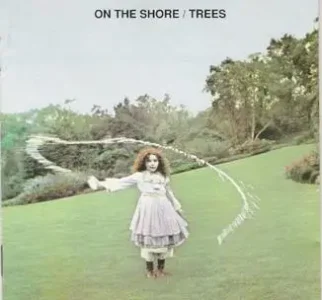Released in 1971, On the Shore was the second and final album from British folk rock band Trees. Arriving during a peak moment for the UK’s folk revival, the album built upon the groundwork laid by their debut, The Garden of Jane Delawney. While their first record leaned heavily into traditional English folk, On the Shore expanded the band’s sound into more ambitious and atmospheric territory. This shift revealed a group growing in confidence, unafraid to blend the haunting qualities of ancient ballads with the layered textures of psychedelic rock.
Rather than turning away from their roots, Trees chose to deepen their exploration of them. Their reinterpretation of traditional songs became more nuanced, and their original compositions displayed a greater sense of narrative and mood. With more complex arrangements and a heavier sonic palette, the album suggested a band striving to connect the past with the present in a way that was immersive and emotionally rich.
Though it didn’t make a major impact at the time of release, the album has since earned recognition for its craftsmanship and vision. It’s often cited as a lost gem of the era—an album that didn’t chase trends, but carved its own quiet path through the landscape of folk rock.
Sonic Exploration

The production on On the Shore strikes a careful balance between clarity and atmosphere. It’s not polished to a modern sheen, but it doesn’t fall into lo-fi territory either. The recordings maintain a natural warmth, allowing the intricate interplay of acoustic and electric elements to breathe. This sound choice complements the album’s themes of timelessness and mystery. Rather than glossing over the edges, the production invites listeners into a world that feels both grounded and otherworldly.
Instrumentally, the album is rich with texture. Celia Humphris’s vocals, both pure and commanding, often sit just above the instrumentation, guiding the listener through each track’s shifting moods. David Costa’s acoustic guitar work is foundational, providing both rhythmic structure and melodic detail. Electric guitar, often handled with a restrained, fuzzed-out edge, weaves in moments of psych-rock influence without overwhelming the folk core. Flute and strings are used sparingly but effectively, creating layers that give certain tracks an almost cinematic feel.
In terms of genre, the album sits firmly within British folk rock, but it’s far from static. It draws from traditional English folk, borrowing melodies and lyrical forms from the past, but reshapes them through a psychedelic lens. Hints of progressive rock appear in the song structures and instrumental passages, while the use of distortion and reverb adds a subtle but unmistakable nod to late ’60s and early ’70s acid folk. The result is a sound that doesn’t settle into any one category, yet never feels disjointed.
Lyrical Analysis

Lyrically, On the Shore is steeped in the lore and mystery of traditional English folk tales. The album’s themes revolve around nature, love, mortality, and the uncanny—a reflection of the centuries-old songs that Trees chose to reinterpret, as well as their original material. There’s a strong sense of narrative throughout, whether it’s a tale of a doomed romance or a ghostly encounter in the woods. These stories are told not as modern commentary, but as timeless myths, echoing with symbolic weight.
Many of the lyrics remain close to their traditional roots, preserving the archaic language and formal structure of folk ballads. This approach lends the album a poetic quality that feels both ancient and immediate. Songs like “Geordie” and “Polly on the Shore” carry a mournful gravitas, where the language is plain yet filled with emotional weight. In contrast, original compositions like “Murdoch” use impressionistic imagery to build mood and tension, allowing for more abstract interpretation.
The emotional range of the album is striking. There’s an ever-present melancholy that runs through the lyrics, but it’s not one-note. Instead, the sadness feels rich and reflective, rooted in a deep empathy for the characters and stories being told. The lyrics don’t just serve as narrative—they enhance the music’s atmospheric pull. They make the listener feel as though they’re walking through a fog-laden forest, hearing these tales whispered through the trees.
Cohesion and Flow

On the Shore unfolds with a natural, almost organic sense of progression. From the moment the first track begins, the listener is drawn into a sonic landscape that feels carefully mapped, yet unforced. The sequencing of the songs enhances this journey. Traditional ballads sit comfortably beside original compositions, creating a rhythm of familiarity and surprise that maintains the listener’s attention throughout. Each track seems to lead into the next with a quiet inevitability, forming a continuous mood rather than a series of isolated moments.
There isn’t a clear-cut narrative in the traditional sense, but the emotional trajectory of the album is unmistakable. It begins with a gentle openness, moves through darker and more introspective passages, and closes with a sense of fading light. This arc mirrors the album’s engagement with themes of love, loss, and the supernatural. The ebb and flow of energy between songs helps the record feel like a complete work rather than a collection of disparate ideas.
The thematic and stylistic consistency across On the Shore is one of its most impressive features. The band maintains a unified aesthetic without becoming repetitive. The blending of folk and psychedelic elements remains steady, and the emotional tone—one of wistful melancholy tinged with mystery—threads through every track.
Standout Tracks and Moments
Several tracks on On the Shore rise above the rest, not because they overshadow the others, but because they crystallize the album’s unique strengths in especially vivid ways.
Polly on the Shore
“Polly on the Shore” is perhaps the most haunting of the traditional songs. Humphris’s vocal performance here is striking—gentle yet full of sorrow—as she recounts a tale of love and loss. The arrangement slowly builds in intensity, with swirling guitars and ambient flourishes that feel like waves crashing around the story’s tragic center.
Murdoch
“Murdoch,” an original composition, stands out for its lyrical ambiguity and dynamic shifts. It begins with a sense of restraint, then opens into a more expansive, almost cinematic soundscape. The use of electric guitar here is especially effective, adding tension without overwhelming the acoustic foundation.
Geordie
“Geordie” is another high point. Trees’ version of the traditional ballad leans into its dramatic potential. The pacing is deliberate, allowing space for each lyric to resonate. The instrumental passages between verses are not just filler—they enhance the mood, making the listener feel the weight of impending doom.
Streets of Derry
One of the most memorable moments on the album comes during the instrumental bridge of “Streets of Derry.” The sudden shift from sparse acoustic guitar to a rich, full-band crescendo mirrors the emotional surge in the narrative. It’s a moment of pure atmosphere, where everything—from production to performance—clicks into place.
Artistic Contribution and Innovation

On the Shore occupies a singular place within the British folk rock tradition. Released at a time when the genre was gaining momentum through bands like Fairport Convention and Steeleye Span, Trees carved out a more ethereal, less rustic path. Where others leaned heavily into either traditionalism or electrified folk revivalism, Trees lingered in a more atmospheric and introspective space. Their sound was softer around the edges, yet no less ambitious.
In terms of innovation, On the Shore brought a subtle yet distinct shift in how folk music could be presented. Rather than simply updating folk songs with rock elements, Trees reimagined them through a lens of mood and texture. Their use of electric guitar wasn’t aggressive or showy, but carefully woven into the acoustic fabric. This helped cultivate a dreamlike sound that would later influence artists in the acid folk and psych-folk subgenres.
Another innovative feature lies in the vocal delivery. Celia Humphris’s voice does not dominate the songs; instead, it drifts through them, often becoming part of the instrumentation. This approach softens the line between storytelling and soundscape, allowing the emotional weight of the lyrics to linger more subtly.
Closing Thoughts

On the Shore is an album that reveals its depth slowly, rewarding listeners who give it time and attention. Its greatest strength lies in its atmosphere—the way it conjures a world that feels both ancient and strangely timeless. From the carefully layered arrangements to the emotionally resonant vocals, Trees created a body of work that is immersive without being overwhelming, intricate without being inaccessible.
The album’s cohesion is another standout trait. Every element, from the production choices to the sequencing of tracks, works in service of a singular artistic vision. There are no obvious weak points or filler tracks. Even moments that seem understated at first gain power through repeated listens, revealing layers of meaning and feeling beneath the surface.
If there is a weakness, it lies not in the album itself but in how it was received. At the time of its release, On the Shore didn’t fit neatly into commercial categories. Its quiet innovations and dreamlike pacing may have limited its immediate impact, but these same qualities have helped it age gracefully.
Rating: 9/10
This rating reflects the album’s lasting influence, its unique sound, and its artistic integrity. While it may not have reached a wide audience in its day, its enduring appeal lies in how it invites listeners into a fully realized world—one that still feels fresh, mysterious, and emotionally resonant over fifty years later.
